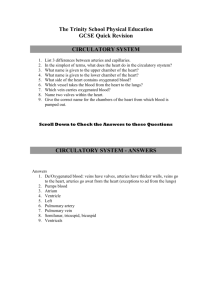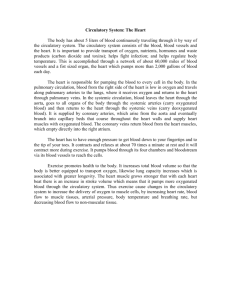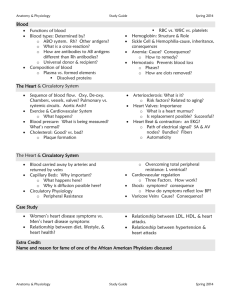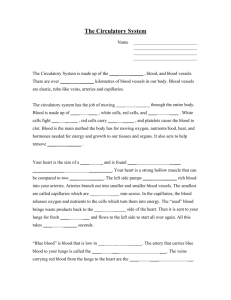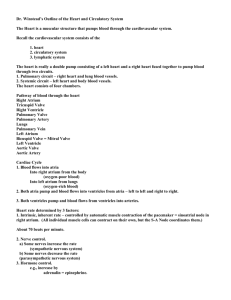File - Ms. Redding's Science Page!
advertisement
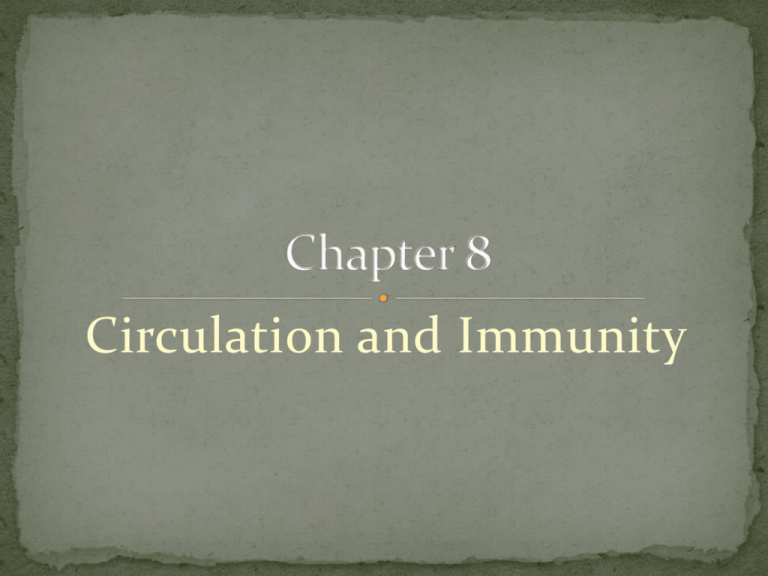
Circulation and Immunity 8.1 Structures of the Circulatory System 8.2 Blood and Circulation 8.3 The Lymphatic System The heart and blood vessels are collectively called the cardiovascular system. The mammalian heart is a muscular organ that contains four chambers and acts as a double pump. There are three circulatory pathways through the body: the pulmonary pathway, the systemic pathway, and the coronary pathway. Blood is a tissue made up of plasma, red blood cells, white blood cells, and platelets. Blood transports materials throughout the body and regulates temperature to maintain homeostasis. The lymphatic circulatory system is closely associated with the blood vessels of the cardiovascular circulatory system. The lymphatic system helps to maintain the balance of fluids within the body and is a key component of the immune system. The body’s defence system is made up of non-specific defences and specific defences (immunity). The specific immune system contains a variety of cells that are specialized to recognize foreign substances and neutralize or destroy them. In this section, you will: identify the major structures of the circulatory system describe the structure and function of blood vessels describe the action of the heart and the circulation of blood through the body dissect and observe the structures of a mammalian heart identify disorders of the circulatory system and technologies used to treat them investigate the relationship between blood pressure, heart rate, and exercise 1. Transports gases, nutrients, and wastes 2. Regulates internal temperature and transports hormones 3. Protects against blood loss and against disease causing microbes 1. Heart – pushes blood through the body 2. Blood vessels – road ways for the blood to travel 3. Blood – carries nutrients, oxygen, carbon dioxide, water and wastes Located to the left of the middle of the chest Size of your fist Keeps oxygen rich/poor blood separate ensuring blood only flows in one direction through the body Walls are made of cardiac tissue – found no where else in the body Involuntary contractions 4 chambers, two atria (top) and two ventricles (bottom) The Atria receive blood from the body or lungs The Ventricles pump blood to the lungs or to the body There is a tick muscular wall between the left and right side of the heart called the septum 1. 2. 3. 4. 5. 6. 7. 8. Right side receives blood (oxygen poor) Blood enters through the vena cavae Blood is pumped from right atria to right ventricle through the tricuspid valve Blood goes to lungs through the pulmonary semilunar valve to pulmonary arteries (only arteries in the body to carry oxygen poor blood!) Goes to the lungs for gas exchange Returns to the left side of the heart through the pulmonary veins (oxygen rich) Left atrium pumps to left ventricle through the bicuspid Blood goes to the aorta (through the aortic semilunar valve) where it then travels to the body Arteries – oxygen rich blood, carried to the body Veins – oxygen poor blood carried back to the heart Blood moves from arteries to deliver nutrients and remove wastes around the body. This is done as the blood moves into capillaries Blood then moves from the capillaries to the veins to return to the heart Arteries (A) and veins (C) have 3 layers. The outer layer is a covering of connective tissue mixed with elastic tissue. The middle layer consists of alternating, circular bands of elastic tissue and smooth muscle tissue. The inner layer is one cell thick and consists of flat, smooth cells. The shape and texture of these cells reduce friction as blood moves through. Capillaries (B) have one layer that is one cell thick. Page 272 – 273 Next Class! This is a formal lab write up – see me for a guideline as to know what will be required of you Working in groups of 3-4 Optional assignment for those who do not wish to participate The stimulus that triggers a heart to beat comes from within the heart A bundle of specialized nerves called the sinoatrial node (SA) stimulates contraction and relaxation of the heart muscle Located in the wall of the right atrium When signalled it generates a signal that travels to another node the atrioventricular (AV) node The signal is then transmitted to the bundle of His that relay it to the Purkinje fibres which initiates the contraction of the right and left ventricles Measured with a ECG Maximum pressure during ventricle contraction is called systolic pressure (when blood goes to the aortas or pulmonary artery) The lowest pressure before ventricle contract again is called diastolic pressure (relaxation of pulmonary artery and aorta) Recorded in mmHg with a spygmomanometer Healthy is 120/80 Cardiac output = heart rate x stroke volume Stroke volume is the amount of blood forced out of the heart with every beat Average person has a stroke volume of 70mL resting and a resting heart rate of 70 beats per minute See chart 8.1 Page 275 Systemic Arteries carry oxygen rich blood away from the heart and veins bring oxygen poor blood back to the heart Pulmonary Arteries carry oxygen poor blood away from the heart and veins bring oxygen rich blood back to the heart See page 276 in text Angioplasty (left) opens blocked arteries. A triple coronary bypass (right) creates three new pathways for blood to travel through because of blockages in the existing vessels. Arteriosclerosis – artery walls thicken and lose elasticity Most common type is atherosclerosis – build up of plaque (fat) along the arteries Can be treated with medicine (asprin) or other medications to help with blood flow and reduce clotting Angioplasty or other surgeries are also options to replace arteries by grafting new ones – page 279 Read summary on page 281 Heart Diagram (Handout) Review Questions: 2,3,4,6,7 In this section, you will: describe the main components of blood perform a microscopic analysis of blood explain the role of blood in regulating body temperature explain the role of the circulatory system, at the capillary level, in the exchange of matter and energy identify certain blood disorders and the technologies used to treat them Left: The three main components of blood can be separated using a special medical device called a blood centrifuge. When the blood is separated, it briefly settles into layers, as shown here. Top: Mammalian red blood cells (erythrocytes) are biconcave disks. Hemoglobin reflects red wavelengths of light so oxygenated red blood cells appear a bright red colour. Point of Comparison Red blood cells White blood cells Granulocytes and monocytes Platelets Lymphocytes Origin red bone marrow red bone marrow thymus, red bone marrow red bone marrow, lungs Cells present per mm3 of blood (approximate) 5 500 000 (male) 4 500 000 (female) 6000 2000 250 000 Relative size small (8 μm diameter) largest (up to 25 μm) large (10 μm) smallest (2 μm) Function to carry oxygen and carbon dioxide to and from cells to engulf foreign particles to play a role in the formation of antibodies (defence function) to play a role in the clotting of blood (defence function) Life span 120 days a few hours to a few days unknown 2–8 days Appearance Constituent Percentage Water ~92% Blood proteins Fibrinogen Serum albumin Serum globulin ~7% Other organic substances Non-protein nitrogen (urea) Organic nutrients ~0.1% Inorganic ions: calcium, chlorine, magnesium, potassium, sodium, bicarbonates, carbonates, phosphates ~0.9% Blood helps maintain temperatures in the body Blood is able to dissipate heat through blood vessels and through the skin if the body becomes too warm Under control of the nervous system vessels dilate to allow more blood heat to be lost from the skin (vasodilation) The opposite process can also happen (vasoconstriction) Alcohol and nicotine can throw the body off in that it increases vasodilation Top: Vasodilation (A) and vasoconstriction (B). Bottom: The deep vein and artery are adjacent to one another, so heat is exchanged from one to the other. As a result, arterial blood is cooled as it nears the hand, and venous blood is warmed as it leaves the hand and returns to the body core. When heat conservation is important, more blood returns to the heart through the deep vein. In higher-temperature conditions, when heat conservation is not a concern, more blood returns through the surface vein. Temperatures are degrees Celsius. Hemophilia – insufficient clotting proteins. 70% of people with hemophilia have a severe form, in that they are constantly in danger of bleeding to death. Leukemia – cancer of the white blood cells. Myeloid is the presence of too many white blood cells (these blood cells are too immature to fight infection and overcrowd red blood cells) and Lymphoid is cancer of the white blood cells themselves Both can be acute (appears suddenly and death soon occurs) or chronic (may have it for months or years without symptoms) Blood transfusions and bone marrow transplants are done as treatment In this section, you will: describe and explain the function of the lymphatic system identify and list the main cellular and non-cellular components of the human defence system describe the role of the cellular and non-cellular components of the human defence system The lymphatic system is a network of vessels, with associated glands and nodes Lymphatic vessels collect fluid (lymph) which is made up of interstitial fluid Helps the body maintain its balance of fluids As blood circulates through the body, some plasma escapes into the interstitial fluid which is absorbed into vessels of the lymphatic system and if needed gets mixed back into the blood White blood cells mature in the lymph nodes which also contain other defense aiding mechanisms – hence when you get sick, your lymph nodes swell because the white blood cells in your body are growing in number! The skin – prevents entry of pathogens White blood cells – use phagocytosis to destroy invading bacteria Immunity – antibodies exist within the body to recognize and destroy disease and pathogens (antigens). This is the main role of lymphocytes: B cells – mature in bone marrow T cells – mature in the thymus gland near the heart Contain antigen receptors to find invading pathogens B Cells Once a B cell binds to an antigen it swells and divides to produce memory B cells that travel in the blood stream carrying information (antibodies) to help fight the invading pathogens After the infection is gone the memory B cells remain to help fight off another attack T Cells Helper T – recognize antigen and give off chemical signals to warn Killer T – bind to infected cells and destroy them Suppressor T – slow or suppress the immune response so that normal tissues don’t get destroyed Memory T – help the body remember previous encounters with a particular pathogen and recognize it quicker the next time Blood Type Antigen on Red Blood Cells Antibody in Plasma A A anti-B B B anti-A AB A and B none O none anti-A and anti-B Individuals with blood type AB are universal recipients (they can receive A, B, AB, or O blood) because they do not have anti-A or anti-B antibodies. Type O individuals are universal donors (they can donate blood to those with A, B, AB or O blood) because their blood cells do not carry A or B antigens and therefore do not react with either anti-A or anti-B antibodies. A person with type A blood can donate blood to a person with type A or type AB. A person with type B blood can donate blood to a person with type B or type AB. A person with type AB blood can donate blood to a person with type AB only. A person with type O blood can donate to anyone. A person with type A blood can receive blood from a person with type A or type O. A person with type B blood can receive blood from a person with type B or type O. A person with type AB blood can receive blood from anyone. A person with type O blood can receive blood from a person with type O. Another important antigen on the surface of red blood cells is called Rh factor, which was originally identified in rhesus monkeys. People who have this protein are said to be Rh+ and those who lack it are Rh-. A person with Rh- blood does not have Rh antibodies naturally in the blood plasma(as one can have A or B antibodies, for instance). But a person with Rh- blood can develop Rh antibodies in the blood plasma if he or she receives blood from a person with Rh+ blood, whose Rh antigens can trigger the production of Rh antibodies. A person with Rh+ blood can receive blood from a person with Rh- blood without any problems. When an Rh- mother gives birth to an Rh+ infant, the Rh- mother begins to make “anti-Rh” antibodies. The mother’s antibodies may be passed to an Rh+ fetus in a future pregnancy and cause the fetus’s RBC to clump, which can lead to fetal death. How does blood maintain homeostasis? What would happen if someone lost a lot of blood in an accident? Compare specific immunity with non-specific immunity. Why can a person with type A or B blood receive a type O blood transfusion? Explain to a partner what allergies are. The cardiovascular system, made up of the heart and blood vessels of the circulatory system, delivers the nutrients and gases received and processed from the external environment to the body’s trillions of cells. The blood circulates through this system, transporting the products of digestion and respiration along the circulatory pathways and moving waste materials from the excretory system. It regulates internal temperature by moving heat produced by the muscular system. It also transports hormones. The heart is a four-chambered, double pump that moves the blood through the three circulatory pathways. The pulmonary pathway transports blood to the lungs. The systemic pathway moves blood from the lungs to the body tissues and back again. The coronary pathway circulates blood to the muscle tissue of the heart. In the systemic and coronary pathways, arteries carry oxygen-rich blood away from the heart, and veins carry oxygen-poor blood back to the heart, where it is pumped through the lungs to exchange carbon dioxide for oxygen. The tiny capillaries, which link the arteries and veins within the tissue cells, are where the exchange of gases, nutrients, and wastes actually takes place. The blood itself is a tissue, made up of red blood cells, white blood cells, and platelets, contained in the formed portion, and plasma in the fluid portion. Each of the elements of the blood has specific functions in the circulatory system. Red blood cells transport oxygen; the white blood cells are part of the body’s defence system; and platelets assist the circulatory system in healing itself. The lymphatic circulatory system is a network of vessels, linked to glands or nodes, which circulates lymph to maintain the body’s balance of fluids. The lymphatic system also works with the body’s defense system to help defend the body against disease. Disorders of the cardiovascular system (such as arteriosclerosis, high blood pressure), the blood (such as hemophilia, leukemia), or the immune system (autoimmune diseases) all impair the transport of nutrients, gases, and wastes throughout the circulatory system. The body’s defence system includes barriers (the skin, eyelashes, cilia, tears), non-specific defences found in the white blood cells (macrophages, neutrophils, monocytes), and specific defences (antibodies). A person’s blood type indicates the type of antigens found on the red blood cell surface. In the ABO system, a person may be type A (with only A antigens), type B (with only B antigens), type AB (with both A and B antigens), or type O (with neither A nor B antigens). Another group of antigens found in most red blood cells is the Rh factor. Within the plasma there are naturally occurring antibodies to the antigens that are not present on a person’s red blood cells. Mixing blood types can result in agglutination.

